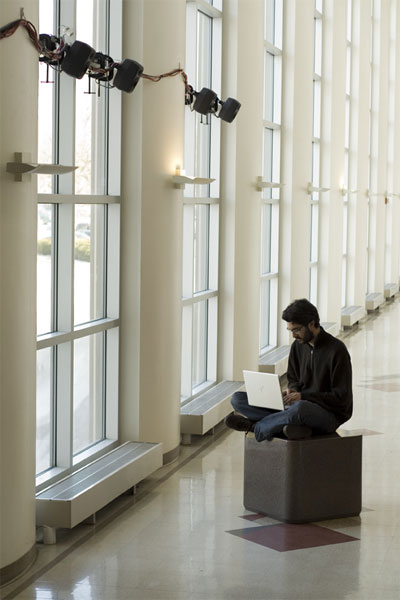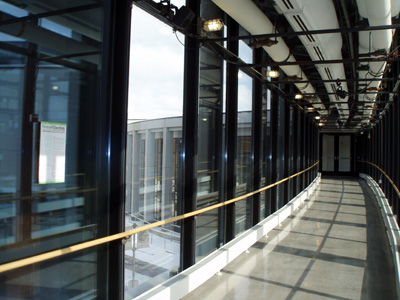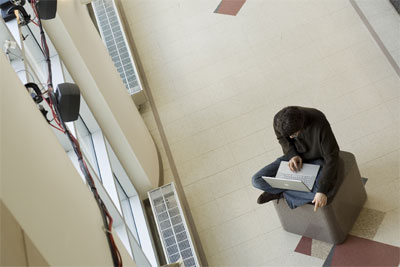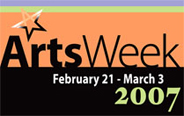
Interacting with Sound Garden at the 2007 installation site.

Sound Garden at the 2009 SPARK Festival of Electronic Music & Arts

"Aerial view" of the 2007 installation.

Interacting with Sound Garden at the 2007 installation site.

Sound Garden at the 2009 SPARK Festival of Electronic Music & Arts

"Aerial view" of the 2007 installation.
Sound Garden is now closed
Sound Garden is a musical work by Norbert Herber, composed for Arts Week 2007 at Indiana University, Bloomington. The project originally ran from 21 February to 7 March, 2007. Most recently, Sound Garden was part of the 2009 SPARK Festival of Electronic Music and Arts at the University of Minnesota, and was installed in the skyway at the Regis Center for Art, February 17–22, 2009.
Sound Garden consisted of both an installation and online interface where participants could join in collaborative, creative music-making in an environment of generative musical systems, environmental sensors, and telematic connectivity. If you have questions about Sound Garden, please read the information below or contact Norbert Herber: norbert AT x-tet DOT com
Sound Garden recordings
There are four recordings of the web stream that were captured in real time while the installation was open to the public. Each MP3 is titled to show the date when the recording was made. For instance "sg-030307-1917.mp3" was recorded at 5:17 pm (EST) on March 3, 2007.
About Sound Garden
Sound Garden is the second work in a series of musical installations that explore the relationship of people, location, and audio relative to technology. In this context, people include those who use, visit, listen to, and tend the garden. Location means both physical and virtual spaces, and audio refers to manifestations of sound, silence, noise, and music. The technology explored in this project specifically includes interactive, telematic systems, digital signal processing (for audio), quadraphonic amplification, environmental sensors, and artificial life (A-Life) systems.
How Sound Garden works
Sound material is to be provided by all who visit, whether online or at the actual site. Help cultivate the garden with your own short recordings, samples, soundscapes, and found sonic objects.
Use the Browse button in the web interface to "plant" MP3 files you would like to hear, or "prune" the garden and uproot files with the Remove button. Sound files must be fixed bit-rate MP3s. No WAV or AIFF, no VBR MP3, and no AAC or .m4a from iTunes.
Listen to the web stream
Sound Garden can be heard live over the Internet at the URL http://hannibal.ucs.indiana.edu:80/soundgarden.m3u Use iTunes, VLC, Real Player, or Windows Media Player to open the web stream. For QuickTime, use icy://hannibal.ucs.indiana.edu/soundgarden.
Physical installation & online interaction
Those who wish to interact by engaging in sonic gardening are encouraged to do so. There are a few technical necessities that, beyond computer and Internet access, should cost nothing. The basic requirements include:
With these you can plant and prune the garden. If you wish to contribute audio material of your own you can use Audacity, a free, open-source, cross-platform audio editor that allows you to sculpt sounds and export them in MP3 format. Download Audacity at the SourceForge web site.
Sound Garden notes
Sound Garden is a continuous work, meaning it is not defined by a performance of any particular duration. Listeners may situate themselves in the garden at the installation site or online and remain indefinitely. The music is characterized by sonic events that are unique in the moment—relative both to the sonic material that nurtures the garden and environmental perturbations that effect its development.
In the tradition of the physical work associated with organic gardens (planting, watering, fertilizing, weeding, pruning, etc.) Sound Garden provides an online interface that allows listeners to tend their sonic environment and take an active role in its composition and care. Using a web browser, listeners can contribute their own digital audio files (musical material, voice and environmental recordings, etc.) and become gardeners that help to form the overall sonic landscape of Sound Garden.
Because each sound is unique, the "seeds" that are planted will significantly effect the primary characteristics of the garden. A generative musical system uses Particle Swarm Optimization (Kennedy & Eberhart, 1995) to grow these seeds and define the overall structure. But Sound Garden is also largely shaped by events that occur at the site of installation. Environmental sensors tracking ambient light levels, temperature, motion, and vibration act on individual sounds that compose the garden. These sensors serve as additional layers in the musical system, and control a variety of signal processing parameters. As environmental conditions shift and change, the sensors reflect that change in the garden's continuous growth and development.
This musical work is primarily concerned with the idea of becoming. In Creative Evolution, Henri Bergson writes about becoming and our perception of reality, "Matter or mind, reality has appeared to us as a perpetual becoming. It makes itself or it unmakes itself, but it is never something made." Sound Garden was developed to explore the idea of music that exists as part of an environment. As such, it is subject to perturbations that ripple through that environment. Like living things, the musical work maintains a kind of autopoiesis (Maturana & Varela, 1980). It acknowledges perturbations in ways that modify (but neither disrupt nor end) its functioning order. This behavior is essential in that it leads to a becoming of sound—music that is making, unmaking, but never made. Listeners attend Sound Garden, but it is never the same Sound Garden.
Here, communications technologies are used to enable an artistic process of collaborative, musical creation through generative systems and self-organization. In improvised music, self-organization is the phenomenon that accounts for the uncanny musical dialogue heard between musicians. In the sciences, particularly in the field of Artificial Life, self-organization is a defining characteristic of living systems synthetic and organic. Similarly, one can find self-organization and emergent behavior on the World Wide Web in wikis, blogs, and community-based sites such as del.icio.us, slashdot.org and digg.com. If one looks carefully enough, self-organized behavior permeates many other facets of the arts, technology, and indeed our daily lives.
The dynamics of self-organization provide two essential ingredients of Sound Garden. In this continuous, generative work, an A-Life algorithm is used to maintain performance and ensure organic development over time. The project is also an experiment in musical self-organization. Like improvising musicians, those who visit Sound Garden will be able to make an individual contribution to the larger, group work. It could be said that this kind of freedom will result in cacophony and leave Sound Garden in a state of complete sonic incoherence. But much in the way that improvising musicians listen to each other in the course of performance, or people contribute thoughtfully and respectfully to a community flower garden, I anticipate that Sound Garden participants will act with sensitivity in response to the musical ecology that is created and sustained by this work.
Norbert Herber
Bloomington, Indiana
2007, revised February 2009
Thank you
Eric Garabrant, Mike Gray & WTIU set shop crew
Ryan Jones, web programming
Olaf Matthes, shoutcast~ & gigaverb~ externals for Max/MSP
James McGookey, streaming server setup
Larry Yaeger, technical advisor (2007)
Elizabeth Raymer, photography (2007)
Bart Vargas, installation coordinator (2009)
Indiana University Department of Telecommunications
Office of the Vice Provost for Research, Indiana University Bloomington
